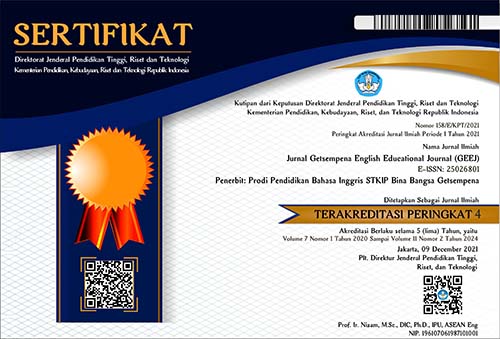THE USE OF DIRECT STRATEGIES IN READING COMPREHENSION
(A Descriptive Study at Senior High School Al-Falah Abu Lam U Aceh Besar)
Abstract
The purpose of this research is to know the direct strategies used by students in reading comprehension at SMA Islam Al-Falah Abu Lam U. The subject of this research is the first grade students of XI 1 at SMA Islam Al-Falah Abu Lam U. Descriptive qualitative method is used to describe the strategies used by students in reading comprehension. The data of this research were obtained by using observation, questionnaire and interview. They are analyzed by using a descriptive explanation. The result show that the students at SMA Islam Al-Falah Abu Lam U used many cognitive strategies in reading comprehension, such as word by word translation, meaningful translation, use dictionary, underlying of keyword and many others. The use of these strategies is to help students in reading comprehension, namely to comprehend the text easily and rapidly. The cognitive strategies that frequently used by students were; using dictionary (resourcing), translated word by word (repetition), reading the title and imagines what the text might be about (summarizing), and reading with comprehend every paragraph to understand whole text (deduction).
References
202-270). Cambridge University Press.
Anne Ratna S, 2014, (oxford, 1990). The Use of Cognitive Reading Strategies to
Enhance EFL Students’ Reading Comprehension. Vol. 2, No. 1. P.1
Arikunto, S. (1996). Prosedur Penelitian Suatu Pendidikan Praktek. Jakarta: PT .
Rineka Cipta.
Arikunto, S. (1998). Prosedur Penelitian Suatu Pendekatan Praktek. Jakarta: PT Asdi Mahasatya.
Arikunto, S. (2006). Prosedur Penelitian Suatu Pendekatan Praktek. Jakarta: PT Asdi Mahasatya.
Arikunto, S. (2010). Prosedur Penelitian Suatu Pendekatan Praktik. Jakarta, PT Asdi Mahasatya.
Ary, D., Jacobs, L. C., Razavieh, A., & Sorensen, C. (2006). Introduction to Research in Education. (7th ed.). Wadsworth, Cengage Learning.
Bamfard, Julian & Richard R,Day .(2004). Extensive Reading Activities for Teaching Language: Cambridge University Press
Brown, H. Douglas. (2001). Teaching by principle: An Interactive Approach to Language Pedagogy.2nd ed. San Fransisco:Longman.
Cambrooke, Kyla Chele (2010), Tips on Note Taking from Textbooks, Available at http://www.ehow.com/list_6548642_tips-taking-textbooks.html.
Cooper, J. David. (2000). Literacy Helping Children Construct Meaning. Boston: Houton Miffin.
Dreyer,C., & Nel, C. (2003). Teaching reading strategies and reading comprehension within a technology enhanced learning environment. System, 31, 349–365
Ellen K. Closs jurnal (Pardo, 2004). Teaching Reading Comprehension to Struggling and At-Risk Readers: Strategies That Work. Michigan.
Frase, Lisa (2008), Reading Strategies Good Readers Use, An article published at http://ezinearticles.com/?Reading-Strategies-Good-Readers- Use&id=1824654.
Frechtling et al. (1997). User-Friendly Handbook for Miexed Method Evaluations. New York: NSF Program Offices Conrad Katzenmeyer.
Gardon. 2007. Technique and Principle in Language Use and Language Learning. London: Oxford University Press.
Glending, E., H & Holmstrom. (2004). Reading: A Course In Reading Skill for Academic
Purposes: Cambrigde University Press.
Grellet, F. (1986). Developing Reading Skill. A Practical Guide to Reading Comprehension
Exercise. London: Cambrigde University Press.
Gulcat, Zeliha (2007), Summarizing, Available at http://www.buowl.boun.edu.tr/students/summarizing/summarizing.htm.
Hancock, Ophelia H (1995). Reading Skill for College Students. 3rd.
Harmer, J. 1991. The Practice of English Language Teaching. Longman Handbook for
Language Teacher. London and New York: New Edition.
Huberman & Miles. (1984). Qualitative Data Analysis: A Sourcebook of New Methods. New
Burry Park : SAGE Publication.
Jones and bartlett , 2005. Jones and bartlett learning LCC. Newyork
Kai-lin yang, 2012. (Alexander & Judy, 1988; Pereira-Laird & Deane, 1997). Structures of
Cognitive and Metacognitive Reading Strategy Use for Reading Comprehension of Geometry Proof. Page 308-326.
Kai-lin yang, 2012. (Anastasiou & Griva, 2009; Sheorey & Mokhtari, 2001) Structures of
Cognitive and Metacognitive Reading Strategy Use for Reading Comprehension of Geometry Proof. Page 308-326.
Kai-lin yang, 2012. (Johnston 1983). Structures of Cognitive and Metacognitive Reading Strategy
Use for Reading Comprehension of Geometry Proof. p. 308-326.
Kai-lin yang. 2012. Structures of Cognitive and Metacognitive Reading Strategy Use for Reading
Comprehension of Geometry Proof. p. 308-326.
Kustaryo, S. (1998). Reading Technique for College Students, Jakarta: Depdikbud Dirjen Dikti P2
LPTK.
Kustaryo, S., & Mc. Taggart, R. 1988. Reading Techniques for College Students. Jakarta:
Departemen Pendidikan dan Kebudayaan.
Lems, K, Miller, L.D, & Soro, T.M (2010). Teaching Reading to English Language
Learners. New York: A Division of Guilford Publications, Inc.
Lilian, L, M., & Virsil G. 1981. Creative Communication (Teaching the Language Art). Toronto.
McGraw Hill Pearson Limited. 62.
Nation, Kate. 2004. Children’s Reading Comprehension Difficulties Reading Fluency. Scientific
Studies of Reading, 5(3), 203–210.
Moleong, J Lexy. (2007), Methodology Penelitian Qualitative. Bandung: PT Remana Rosdakarya.
O'Malley, J&Chamot, A (1990), Learning Strategies in Second Language Acquisition,
Cambridge University Press, New York.
Oxford, R L (1990), Language Learning Strategies: What Every Teacher Should Know, Newbury
House Publishers, New York.
Pressley, Michael, (2000), A Focus on Reading Comprehension Strategy
Instruction,Availableathttp://www.readingonline.org/articles/handbook/pres sley/index.html.
R. Day, Richard & Julian Bamfard. (1998). Extensive Reading in the Second Language
Classroom: Cambridge University Press.
Sahin, Ayfer, 2013, (pardo, 2004). The effect of text types on Reading Comprehension. Mevlana
Internasional Journal of Education (MIJE), 3(2), pp. 58.
Sahin, Ayfer, 2013 (Torgesen, Rashotte, Alexander, Alexander and MacPhee, 2003). The effect
of text types on Reading Comprehension. Mevlana International Journal of Education (MIJE), 3(2), pp. 58. Sugiyono. (2010). Metode Penelitian Pendidikan. Bandung: Alfabeta. Sugiyono. (2011). Metode Penelitian Pendidikan. Bandung: Alfabeta.
Suwarno., & Wiryodijiyo. 1989. Membaca: Strategi Pengantar dan Tekniknya. Jakarta: Proyek
Pengembangan Lembaga Pendiddikan Tenaga Kependidikan. 57.
Suzane I. Barchers, Teaching Reading Process to Practise, (New York: Wadsworth Publishing
Company, 1998), p. 14.
The National Reading Panel Report [NICHD], 2000. A Closer Look at the Five Essential
Components of Effective Reading Instruction: A Review of Scientifically Based Reading Research for Teachers. p. 1.
Westwood, Peter. (2001). Reading and Learning Difficulties: Approaches to Teaching and
Assessment. Victoria: BPA Printed Group.
Yai-li lai, yu-jung tung, shu –ying luo, 2008. Theory of reading strategies and its applicantion by
EFL learners : reflections and two case studies. p. 153-165.
























